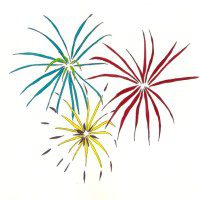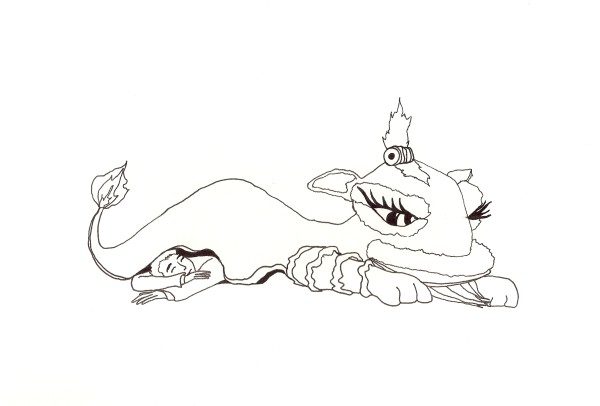I heard the percussion first, the dong-chiang, dong-dong-chiang of the drums and cymbals that accompanied the lion dance. The rhythms reverberated in the body and drowned out the traffic around the Far East Center in west Denver. The crowd on this first day of the Chinese New Year spanned multigenerational Chinese families, curious onlookers from the suburbs and the adjacent Mexican neighborhood, white couples with adopted Chinese daughters, mixed-race couples and their children, and immigrants like Mark and me. We walked toward the platforms on which the lions danced and looked for my Aunt Deborah.
The lions were each red, blue, yellow, or black, with furry white trimmings like fish scales. Two men propped up each costume, one at the head and the other at the tail, their faces hidden by the bright cloth. Two lions leapt onto the support beam that served as a makeshift stage as the others watched on. They battled each other, ate red packets, and even paused to rest and sleep. The highly stylized movements resembled those of the martial arts. Shop owners hired the troupes to perform before their premises, a gesture they believed would bring luck and prosperity in the coming year. In doing so, they also created a gathering in the midwinter chill.
In the traditional southern style lion dance, the lion embodies Nian, a mythological beast that descends on villages around the new year, destroying crops, attacking children, and otherwise wreaking havoc. In one such attack, the villagers scared the beast away by lavishly displaying the color red, banging their pots and pans, and setting off firecrackers. Afterwards, they decided to preempt the beast every year by dancing in the streets, flaunting the color red, and making a lot of noise. The lion dance emerged from this symbolic slaying of the beast. It has since evolved into a celebration, and the the lions have turned into emblems of life, luck, and happiness. The rousing percussion and the color red remain.
***
I left Singapore for America at nineteen, and I have rarely celebrated Chinese New Year since. I have long associated the festival with putting up appearances. But this year, Aunt Deborah, my mother’s cousin, invited Mark and me to join her, her son Michael, and her partner Donald for the lion dance at the Far East Center, after which we would adjourn for dim sum. “One of the houses between your mum’s and ours had a troupe every year,” she had told me. “I grew up waking to the firecrackers and drums, and Chinese New Year isn’t the same without it.”
The day before, I had read Rebecca Solnit’s essay “We Won’t Bow Down,” in which she describes the civil society and sense of community that arises from the largest public celebration in America, the weeks-long Carnival in New Orleans that culminates in Mardi Gras. Carnival begins on Twelfth Night and ends on the day before Lent, and Mardi Gras is known for the big downtown parades and riotous parties. Carnival, Solnit argues, “reinforces joy and ownership of public space and a kind of confidence in coexisting with a wide array of strangers. New Orleans itself is the place where, unlike the rest of the United States, slaves were not so cut off from the chances to gather and chances to maintain their traditions…They didn’t bow down. This is something to celebrate, and it is what is celebrated by some people in the streets.”
The traditional Chinese New Year rites begin on the eve of the day with a family-reunion dinner. The first day is usually spent visiting paternal relatives, the second day maternal relatives. The rest of the fifteen days are spent alternating between rest; gathering and feasting with family and friends; making offerings to the ancestors and gods; and, on the last day, attending a street festival. At least, that’s how they’re spent when you have fifteen days off from work and school. The celebrations I knew in Singapore were truncated to the second day. That is to say, Chinese New Year became a retreat from the streets.
Admittedly, my family did not attend Chingay, the Singapore street festival staged around the fifteenth day. We favored the private, the apparent order of the home over the clamor of the streets. Because we were part of Singapore’s cultural majority, our ways were taken to be the norm, the core of the social landscape. We did not need to assert our ownership of public space. But Chingay also strikes me as officious, organized from the top rather than from the ground, turning us into spectators rather than participants. And the street festival was only adopted after the government had banned firecrackers for safety reasons; Chingay is also the official substitute for the spirit of Chinese New Year.
Chinese New Year in Denver is a far cry from Carnival, but it is a public celebration in a city where the historic Chinatown is remembered mostly for its 1880 race riot. (Similar clashes across the nation led to the passage of the 1882 Chinese Exclusion Act.) The largest public procession in Denver may be the annual National Western Stock Show parade in January, during which cowboys, cowgirls, and Texas longhorns march down 17th Street amid the glass and concrete of the financial district. The Stock Show does not have as big an impact on Denver’s culture and economy as Carnival has on New Orleans’s, but it is a break in routine and brings people to the streets. Chinese New Year has an even smaller impact on Denver, but when I went to the Far East Center, I saw it as a primer for street celebrations.
***
“It’s usually a zoo,” Aunt Deborah had said. Later, she and Donald would tell us that this year’s turnout was smaller than usual, likely because of the cold spell. It had snowed the night before, and snow still lined the streets. Despite the cold, we, Chinese and non-Chinese alike, had gathered at the Far East Center to revel in the rhythms of the lion dance. I watched a children’s troupe set up lions and a dragon before a Vietnamese restaurant. The children would have had a feast with their families the night before, I thought, and now they were going to perform in public, negotiating a space for themselves as individuals and for the Chinese community in the social fabric of Denver.
The shifu beat the drums. The children clashed the cymbals. A dozen children picked up the sticks and propped up the dragon. The long orange cloth billowed in the wind, a lithe body flowing behind the dragonhead. The moves of the dragon dance are similar to those of the lion dance, both taken from the martial arts, but in the dragon dance, the cloth does not cover the faces of the dancers. Another group of children pulled tiny lion costumes over their heads and fanned out into the crowd, wriggling the beaded eyes and kicking up the tails, feeding on red packets stuffed with a token sum or chocolates wrapped in gold foil.
A dancer lit the firecrackers. The red rolls crackled and the chains burst. The air filled with smoke. The explosions enveloped even the drums and cymbals, echoing in my bones. I stood there in a state between shock and euphoria, between a desire to dissolve into the sound and a desire to recoil from the flying fragments of paper and gunpowder. It was the first time I had seen live firecrackers, and the only thing I’d seen that matched its force was an avalanche in the Rockies, where a slab of wet snow crumbled and crashed on a rocky ledge. It was as if a wall had ruptured inside me and a joy had spilled beyond my skin.
***
Rumpus original art by Annie Daly.





